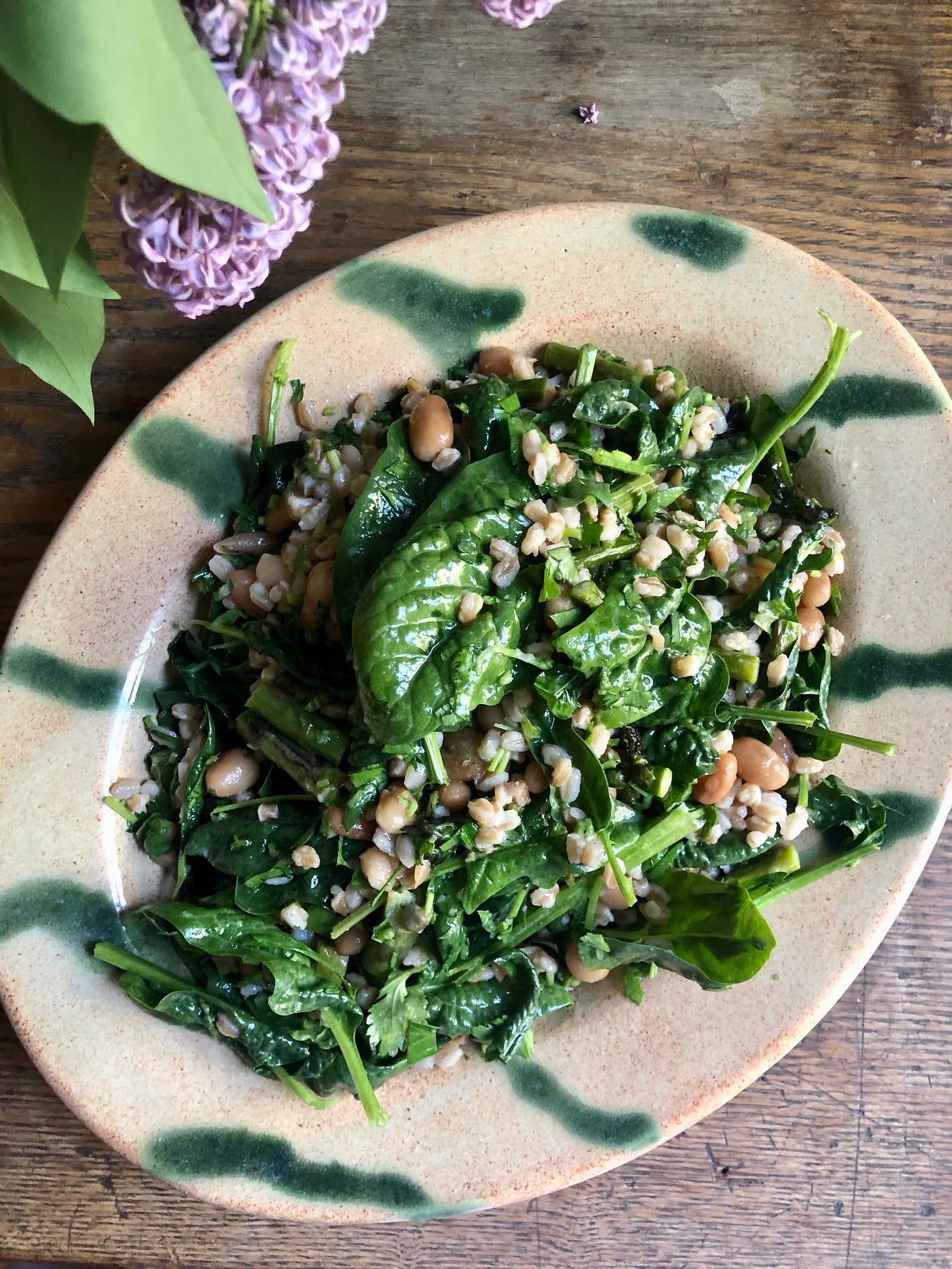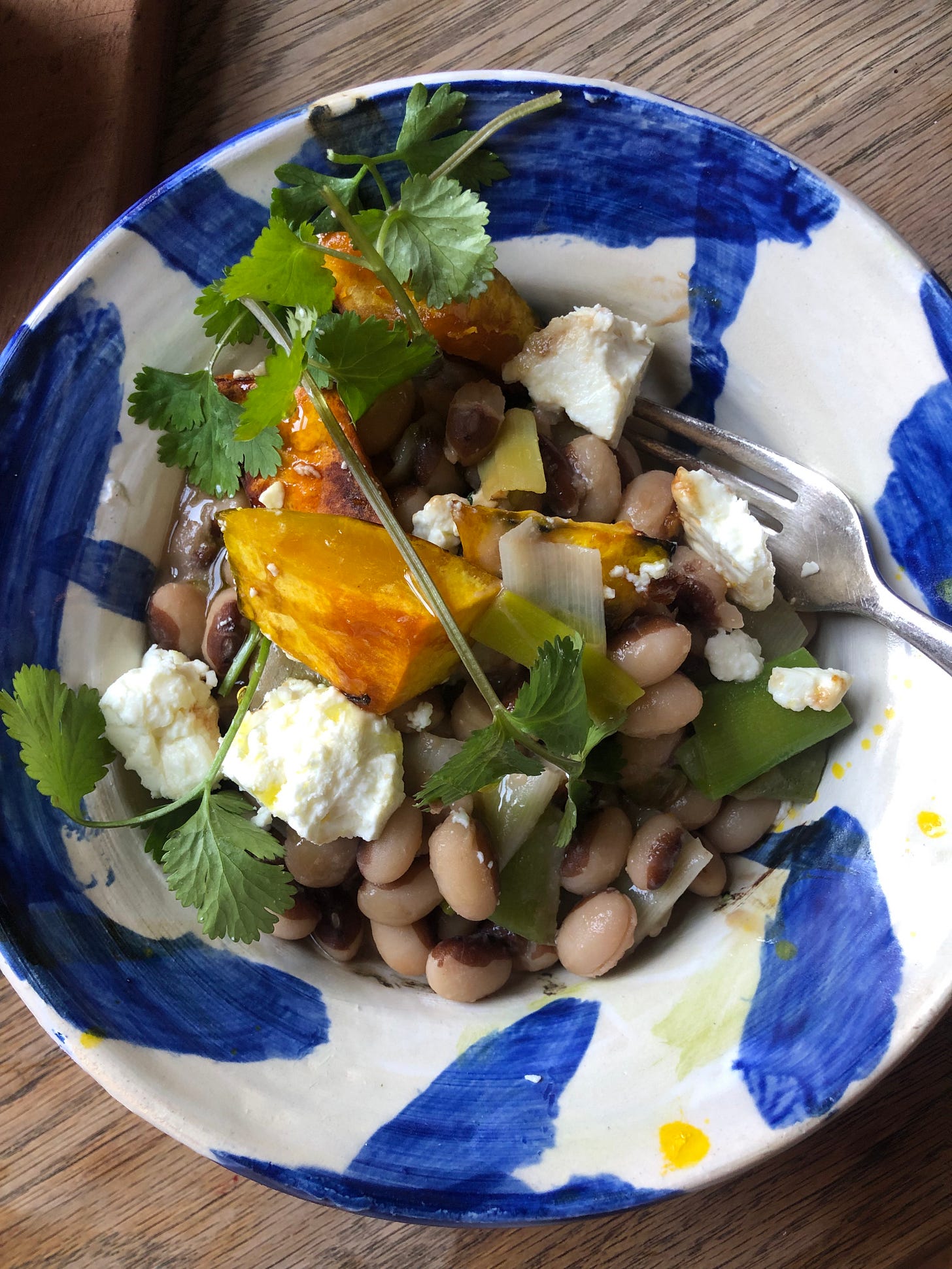Beans! Beans! And More Beans!
My guide to cooking beans, plus a recipe for beans and leek w roasted squash and feta
Beans
Beans! Beans! And more beans!
Beans are very much a dietary staple in my house. I almost always cook them from scratch and prefer to keep the flavouring simple so that they can be incorporated into as diverse a range of dishes throughout the week as possible.
Beans are so endlessly versatile it is really pretty easy to make a big pot of beans disappear over the course of a few days. Because of this I always cook at least a pound (half a kilo) at once, any that you feel you may not use can easily be frozen to use later at a moment’s notice.
When paired with a carbohydrate, beans become a complete protein- hence rice and beans, bread and hummus, baked beans on toast (!) and other myriad traditional ways of pairing legumes and starch. I always keep this principle in mind when cooking vegetarian or vegan dishes.
At Astro, the cafe I owned and ran with my husband in Detroit for over a decade, we always made a daily counter salad. As a base we generally always used a legume- bean or lentil- and a grain- usually farro, kamut, freekah or quinoa (not technically a grain but a seed)- and then supplemented this with seasonal vegetables and often nuts or seeds. It was pretty much always vegan, and it was different almost every single day. I didn’t write any of the recipes down because there were no recipes, which over the course of 10 years makes over 3,000 different salads. Needless to say, the possibilities are endless when using beans in a salad!
Buying beans can be somewhat overwhelming. I love bougie, heirloom beans such as those from Rancho Gordo, but I also think that one of the beautiful things about beans is that they are a really cheap way to feed a lot of people. Very average, cheap beans, can also be perfectly wonderful and all that you need, so don’t feel that you have to buy the best beans on the market in order for them to be good. I do generally go for organic beans because they are often fairly heavily sprayed otherwise, but that is just my personal preference. As for varietal, it is worth just trying them and learning the differences yourself. Some beans hold their shape more than others- such as mayacoba and black and yellow eyed peas- while others get really soft and creamy- such as cannellini or pinto.
Cooking beans can be broken down to four important components:
1) Soak overnight. Place the beans in a big bowl and cover with a few inches of water. If I am cooking the beans first thing in the morning, I will soak them before I go to bed and leave on the counter. If I am waiting longer before I am going to cook them, I’ll soak them in the fridge. This step is crucial if you don’t want to spend up to 6 hours cooking the beans! It also helps to ‘pre-digest’ the bean to make it easier on the stomach- sourdough bread works in the same way, as does soaking brown rice overnight. The exception to the soaking rule is if you have very fresh dried beans- less than a year old- which you may find at a farmers market or from a local grower. For these beans (and you can talk to the grower to find out for sure) they often don’t require soaking before cooking.
2) Cook the beans over GENTLE heat with just enough liquid to cover by an inch or two- add a little more water if it gets too low, but not too much or the flavour will be diluted. Be sure to strain away the soaking water and use fresh water for cooking. Skim off any foam that rises to the surface as you cook them. I romanticize having an open fireplace where I can cook a terracotta pot full of beans over the embers for an entire day, alas my stove and a heavy based pot also works perfectly well.
3) Salt them properly! This goes for any cooking really, but beans without enough salt are just sad. I think when you aren’t used to cooking in a commercial kitchen it can feel shocking to add the ‘correct’ amount of salt needed to make food taste good, but it is especially important with beans. As always, start with less and add more to taste, but do TASTE TASTE TASTE. Note that the beans will take a moment to take on the flavour of the salt, so season and then allow at least 5 minutes of cooking before you taste. I always salt my beans towards the end of cooking, I was told long ago that this ensures they don’t become tough, but to be honest I’m not sure it makes much difference, especially if using better quality beans.
4) Not part of the cooking, but an important step- store the beans in the cooking liquid! It is pure flavour and will ensure your beans don’t dry out in the fridge before you use them. I use the liquid in soups or use it to re-heat the beans. It’s as important as the beans themselves and the number one reason I don’t love using canned beans- the canned bean goop is just plain revolting compared to homemade bean liquid.
When it comes to flavouring the beans, I like to add a few cloves of unpeeled garlic (you can cut off the ends to make it easy to squeeze out the soft garlic at the end) and sometimes an unpeeled onion, washed to remove any grit from the roots and then halved- keeping the root intact so that it is easier to remove when finished cooking. Herbs such as a couple of bay leaves or a few good branches of rosemary are my favourites to add, but thyme, oregano, sage, parsley or cilantro (stalks only for the latter two) are good too- it is easiest if you tie them up with a pieces of kitchen string, otherwise you have to go fishing for soggy herbs later on, which is what I usually end up doing! As a general rule, unless I know what I am doing with the beans, I go for just garlic, onion and maybe bay while cooking to keep the flavour open for greater flexibility later on. That way I can use some of them in an Italian sausage and bean soup, some to fill tacos and others with ginger, sesame and cilantro in a salad.
I often add a good healthy lug of olive oil towards the end of cooking my beans. This small steps really improves the luxuriousness of the beans and their liquid. I find this is especially good if I am using the beans in a salad or a vegetarian soup or stew, something where there won’t be much fat added later.
There really are so many ways to use beans, but here are a few quick ideas:
Salads:
Cranberry or cannelloni beans, tomato, basil, onion, tinned fish such as tuna or sardines (or sub some lovely big shavings of cheese such as pecorino or parmesan), lemon juice and olive oil, bread to soak up the juices
Yellow or black-eye beans with dill, parsley red onion, tomato, cucumber, lemon juice and olive oil, feta optional, bread to soak up the juices
White beans or cranberry beans, farro, roasted squash, arugula, a little chopped rosemary in a red wine vinaigrette
Cooked beets, tossed in sherry vinegar, pinch salt and olive oil. Beans (mayacoba, yellow/ black eye or white beans), dill, parsley, kamut (optional) avocado or feta (optional)
Asparagus and farro salad with beans and spinach (pictured above)
Soups/ stews:
Italian sausage, fennel, mirepoix, garlic, kale, potato, beans
Beans and poblano peppers (excellent in or with tacos if you cook out most if the liquid)
Bacon, white beans, mirepoix finish with sour cream and chives
Roasted squash (pumpkin), white or cranberry beans, sage or rosemary, mirepoix
Dips: I love to just throw a bunch of things in the food processor and blend. Great to serve with bread or crudités or as a base for a veggie sandwich.
White beans, garlic, lemon zest, thyme, dill, lemon juice, olive oil, salt and pepper
White beans, rosemary, lemon, garlic, olive oil, salt
Roasted squash, chickpeas, ras el hanout, lemon, cilantro, garlic, pomegranate molasses, olive oil
Beans with Leeks, Roasted Squash and Feta
Beans and leeks are particularly good friends. I made this dish in two parts: the beans and leeks and then a bowl of roasted squash and feta on the side that we piled on top of the beans as we ate it, a piece of good bread in hand. Delicious!
Keep reading with a 7-day free trial
Subscribe to Still Life With Lemon to keep reading this post and get 7 days of free access to the full post archives.





